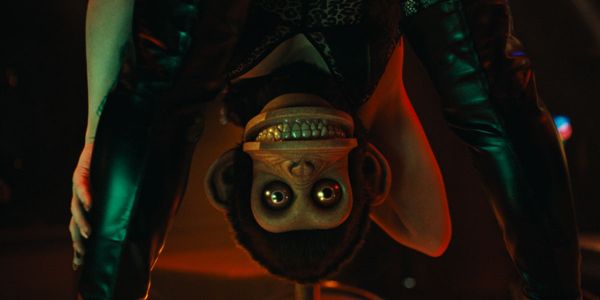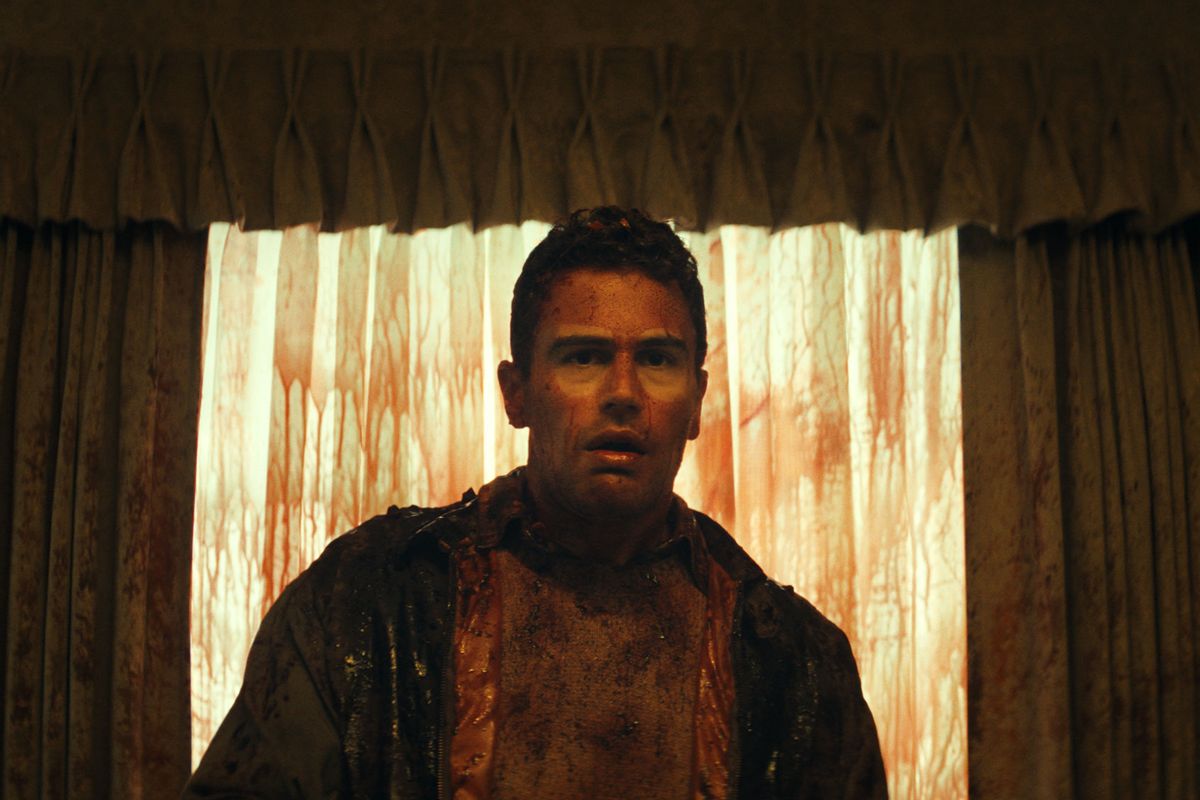Do you think about death a lot? Are you scared of it? Does it affect your life and your choices? Do you grieve easily? Have you come into close contact with death? Do you think about how you’d like to die? Has your life ever flashed before your eyes? Are there things you want to do before you die? Do you owe anyone an apology? Whose death will make you the saddest? What would you like people to remember you for after you go?
For a movie that starts dying a slow, painful death from its first act, its attempts to lampoon our fear of death are ironically futile.
These are some of the questions Osgood Perkins lobs at viewers in his new film “The Monkey.” They’re also questions that I’ve been more inclined to contemplate after absentmindedly chewing on the package of silica gels that come in a bag of beef jerky than I was while watching “The Monkey.” For a film positively obsessed with death, Perkins’ latest feature, adapted from a short story by Stephen King, has very little to say about our demise other than crudely commenting on its inevitability. A bevy of convoluted, gory sequences comprise the film, stressing death’s unpredictable and unfair nature. Other times, characters spit the truth at viewers much more plainly. “Everyone dies and that sucks” is repeated so often throughout the movie that it starts to sound more like a serenity prayer than a frank mantra. (A more explicit version of this phrase is also the film’s tagline.)
Yes, death is inescapable — that much has been drilled into our consciousness especially hard in the first few weeks of 2025 alone. Disappointment, however, is not so certain. Yet, it’s disappointment that Perkins serves up most frequently in “The Monkey,” detouring from every wide-open chance to showcase depth and humanity in favor of juvenile humor and gross-out splatter gags. Given that Perkins is still fresh off the success of his excellent breakout film “Longlegs,” the frustration is only magnified. In his latest, the writer-director pivots from the eerie thematic abyss he explored in last summer’s surprise hit to swim back up to the surface and stay there, trying to have a laugh or two as he catches his breath. As long as the jokes are funny, there’s plenty of space for humor in horror. But the film’s scattershot writing leaves its punchlines hitting dead air before falling smack against the floor. For a movie that starts dying a slow, painful death from its first act, its attempts to lampoon our fear of death are ironically futile.
That’s also one of the movie’s most glaring faults: “The Monkey” is certain that humans don’t think enough about death as it is, that we’re oblivious to the fact that it surrounds everything we do. Perhaps it’s a case of bad timing, seeing as the film is hitting theaters when planes are falling out of the sky. (A shot in the movie depicting just this feels particularly unsettling given the circumstances). But Perkins hops so quickly from one outrageous death to another that his screenplay leaves little room for rumination amid his constant fatalist sermonizing. Forget getting to know a character, or building empathy to connect a viewer to the person they’re watching onscreen. The fact that we’re all going to die isn’t a good enough excuse to write characters who serve no other purpose than to parrot the same cynical agenda. This kind of thin writing keeps the viewer at an arm’s length; not just disconnected but bored, no matter how excessive or bloody the deaths onscreen become.
But for those who are merely interested in the gore in this glorified splatter film, the carnage starts early and rarely lets up. In 1999, Captain Petey Shelborn (Adam Scott, in one of the film’s handful of cameos that excite for more than they’re ultimately worth) tries to return a toy monkey to a novelty store. Petey explains that, once you turn the wind-up key in the monkey’s back and the primate begins to bang his little drum, someone nearby is “utterly f**ked.” Not believing him, the salesman behind the counter becomes the sole fatality in a freak harpoon gun accident that’s much more disgusting than I’m giving it credit for. Perkins finds stable footing when “The Monkey” leans into the extremes of its gore and situational humor to tee up that brutality. Unfortunately, he never goes as far with the circumstantial death gags as, say, the “Final Destination” or “Saw” franchises, leaving the death scenes excruciatingly uneven aside from a couple of memorable casualties. Come for the Rube Goldberg machines, leave feeling like a rube.
 The Monkey (Courtesy of Neon
The Monkey (Courtesy of Neon
Witness to most of those deaths is Petey’s son, Hal Shelburn (Theo James), who discovered the monkey’s malevolence as a child when he found it tucked away among the junk his estranged father left behind. Hal and his twin brother Bill (played as a kid by Christian Convery) got a firsthand look at what this seemingly innocuous toy could do to their loved ones after a couple of fateful wind-ups. Knowing that the monkey would only keep killing, they threw it down a dry well, only for it to reenter their lives 25 years later.
Now, the brothers haven’t seen each other for decades. Bill fell off the grid, while Hal still lives and works near the town they were raised in. Hal even has a son of his own named Petey (Colin O’Brien), after his father, whom he sees just one week a year for fear that the inexplicable events of his childhood will somehow glom their way onto Petey. When Hal’s week with his son rolls around, he receives notice that an old family member has incurred a grisly death involving fishing hooks, natural gas and a realtor sign staked in her front yard. It’s too absurd to be anything but the damn monkey.
Want a daily wrap-up of all the news and commentary Salon has to offer? Subscribe to our morning newsletter, Crash Course.
Since the monkey has somehow attached its evil to their family, Hal knows his next step is tracking down his brother, if only to determine that Bill is safe. This presents an opportunity for a wild goose chase, filled with death, destruction and buckets of blood. Instead, Perkins opts for something far more convoluted, mixing in dead-end narrative asides that seem like they’re headed in an exciting, new direction before dropping off completely. Occasionally, a shot or set piece that’s entirely out of step with the rest of the movie will appear, leaving the viewer to scratch their head and wonder about what the point is. Shoehorning these random digressions into the film without any additional context to surmise their meaning just feels like Perkins is doing weird for weirdness’ sake. There are far more awkward “what the hell was that” chuckles than resounding belly laughs to be had.
By depersonalizing death and making it into a rote spectacle, Perkins loses any heart that could give his film the resonance it so desperately needs.
For example, following two prominent deaths, a group of local cheerleaders waits nearby, reacting with excitement at the sight of a dead body. One could read this strange, extraneous sight as Perkins’ attempt to send up our macabre fixation with death, rubbernecking at gruesome sights we should want to turn away from. But “The Monkey” is already so entrenched in this phenomenon that the strange cheerleading metaphor reads like a joke that doesn’t land — not exactly out of place with all of the other gags meeting a similar fate. Some other shots are so incongruous that they’re less like jokes and more like editing mistakes, making the film genuinely difficult to follow at points. That would easily be less noticeable if “The Monkey” had a beefier central narrative, but Perkins opts to flesh out King’s source material with humor over added plot, and the film is all the weaker for it.
Because “The Monkey” arrives so soon after “Longlegs,” it’s difficult not to compare the two. “Longlegs” had an original screenplay written entirely by Perkins, and while the film took notable inspiration from “Silence of the Lambs,” it was heralded for Perkins’ ability to use thorny themes to build out a distinct, dread-filled framework. “Longlegs” had a lot on its mind, from how humans weaponize religion, to sexual abuse and the way trauma plays with the memory — not to mention a whole lot of Satanism. With “The Monkey,” Perkins seems to be careening in the other direction, going far more literal with his depiction of humanity’s capacity for evil. Perkins has spoken about taking liberties with the story, bringing in his own notable experiences with horrible, “headline-making” death. (His father, actor Anthony Perkins, died of complications with AIDS while his mother, Berry Berenson, died in the September 11 attacks.) Perkins sought to depersonalize tragedy so he could make a movie that continually emphasizes that death is a thing that happens to everyone; sometimes it’s clean and easy, other times, someone gets trampled by wild horses.
But by depersonalizing death and making it into a rote spectacle, Perkins loses any heart that could give his film the resonance it so desperately needs. Unlike similar franchises confronting the inevitability of death, “The Monkey” approaches that certainty with a shrug. “We’re all going to die, so we might as well get used to it” might have some level of truth to it, but that messaging is wholly counterintuitive to an already disconnected world. Sure, we’re all going to die. But just because it’s destined doesn’t mean it’s not still deeply sad. That melancholy provides critical nuance to our lives, keeping them from being pointless in the face of sure annihilation. Without elucidating those necessary subtleties, “The Monkey” has no more value than the glib words of comfort whispered by a family friend who only came to the wake for the free food.
Read more
about recent horror comedies



Shares